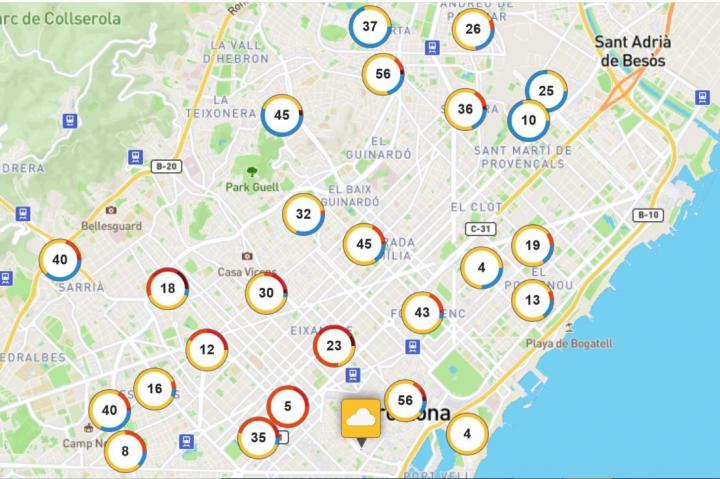
Credit: Perelló, J. et al. (2021)
A study led by University of Barcelona researchers and carried out together with more than 1,650 students and their family members from 18 educational centres in Barcelona shows that citizen science is a valid approach able for doing high quality science, and in this case, able to provide nitrogen dioxide values with an unprecedented resolution and to assess the impact of the pollution in the health of their inhabitants.
The journal Science of the Total Environment has published the results of a study carried out by the research group OpenSystems of the University of Barcelona, the Barcelona Institute for Global Health (ISGlobal), promoted by La Caixa Foundation and the 4Sfera company, that shows the key role of citizen science in the relationship between the assessment of the exposure to air pollution and the collective action for the improvement of air quality.
The publication describes the xAire project, which involved the organization of collective data gathering in Barcelona regarding the concentration of nitrogen dioxide, a pollutant related to the motorized vehicles. This concentration was measured during a 1-month period between February and March 2018 thanks to the families with children aged between 7 and 18, from 18 public primary schools in the different districts of the city.
The results provide unprecedented information on the pollution of the air in the city with a notable precision. The location of the measuring spots was decided autonomously among the students and their families following the same scientific process. “xAire has not only shown the problems surrounding the schools and the neighbourhoods but it has also provided arguments to the families and schools to ask for improvements in their environment according to the data they gathered”, notes Professor Josep Perelló, leader of the study and member of the Institute of Complex Systems of the UB (UBICS).
Air pollution in Barcelona, a serious and underestimated problem
The results of the research show a wide and representative distribution of nitrogen dioxide concentration levels of the city regarding population density. The study analysed very high levels, with an annual average of 49 μg/m3, above the thresholds of the European directive and the WHO, which are 40 μg/m3. More than 5% of the samples double the threshold value of 40 μg/m3, thus confirming that air quality is a serious problem in Barcelona. The measured levels also show large differences between districts and within the same district, depending on the street. The average values obtained in Ciutat Vella, Sants / Montjuïc, Les Corts and Horta / Guinardó by xAire are particularly worrying, as they are higher than those of the nearest official stations.
Improvements in a model of the pollution impact on health
The obtained data have also made it possible to obtain a more up-to-date and accurate estimation of the models for estimating the impact of NO2 on health used by the scientific community. Specifically, the study has estimated that 1,084 new cases of childhood asthma are attributable to NO2 each year in Barcelona, an equal figure to 48% of the total annual cases. According to Mark Nieuwenhuijsen, head of Urban Planning, Environment and Health Initiative of ISGlobal, “if we reduce NO2 levels, especially around schools, we could significantly reduce cases of childhood asthma”.
A coordinated effort to measure pollution in 725 areas of the city
xAire was born with the aim to expand the detail and representativeness of the city’s levels of pollution, provided by the city’s seven official stations. The effort with more than 1,600 involved people has resulted in measurements of nitrogen dioxide in 725 locations. The number of obtained samples exceeds previous campaigns conducted by professional scientists, who gathered the concentration of nitrogen dioxide in a maximum of 200 locations simultaneously.
The xAire project returned the data to each school group and these are available publicly on an interactive map. The results were discussed in the schools mainly considering the WHO and EU limit values. The discussions showed a clear understanding of the follow-up data and the scientific research process.
Boys and girls aged between seven and eight were able to perfectly explain the scientific protocol and the meaning of the data in the InfoK of the Super 3 Channel, during the Science Congress, organized by the Barcelona Education Consortium and in front of the city mayor Ada Colau (Escola El Sagrer). The same schools provided the data to City Council officials along with a set of proposals based on scientific evidence, at an event held in Saló de Cent. The proposed measures range from the promotion of public transport in the neighbourhood and pedestrian routes to the need to cover part of the ronda de Dalt (Dolors Monserdà, Sarrià) or to accelerate the reform of Avinguda Meridiana (El Sagrer).
Large-scale citizen science campaigns on air quality should not be seen simply as a public awareness activity and an education program. “In this intense participatory component, citizens can be actors in research and not just recipients of a message. This approach to citizen science adds sophistication and diversity to the scientific research process, as it requires multidisciplinary professional scientists and the participation of non-academic organizations”, says Isabelle Bonhoure, researcher at the OpenSystems Group of the UB.
###
Media Contact
[email protected]
[email protected]
Original Source
https:/
Related Journal Article
http://dx.




